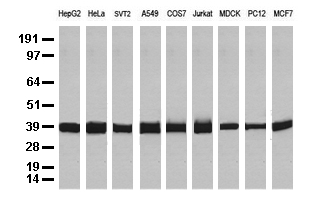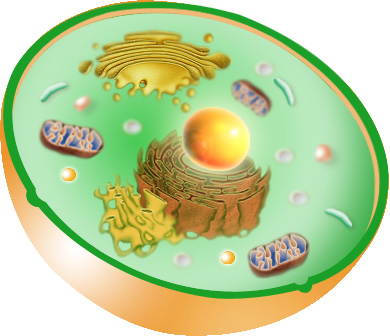内参抗体
内参蛋白一般由持家基因表达的蛋白来担当,它在各组织和细胞中持续表达且表达量相对恒定,比如GAPDH , beta-tubulin 和beta-actin , 常在参照物某些功能蛋白表达水平变化的检测中做。内参抗体可以用来判断实验样本是否上样量均一,这些信息可以用来衡量上样量差异和不同样本之间蛋白表达的差异。查看更多的 内参抗体FAQs。
根据样本的不同,有以下内参可供选择
>> 内参对照抗体试样套装(小鼠) TA150046
内参抗体示例

- Western blot analysis of extracts (35ug) from 9
- different cell lines by using
anti-GAPDH monoclonal
antibody,Loading Control (TA802519)
- Immunogen: Full length human recombinant protein of human GAPDH (NP_002037) produced in HEK293Tcell.
- Reactivity: Human, Mouse, Rat, Dog, Monkey
- Application: WB
- Predicated MW: 35.9 kDa
- Citations:
为什么选择OriGene 内参抗体?
内参抗体背景资料
Beta-actin,is an isform of actin proteins. Actins are highly conserved proteins that are involved in cell motility, structure, and integrity. There are six different but highly conserved actin isoforms in vertebrates. Four of these isoforms are expressed primarily in striated and smooth muscle cells, whereas the two cytoplasmic β-actin and γ-actin isoforms are ubiquitously expressed. Conserved from birds to mammals, β-actin and γ-actin differ at only four biochemically similar amino acid residues. These amino acid differences confer different biochemical properties between the two isoforms. Beta-actin is a major constituent of the contractile apparatus.
Beta-actin, also known as a "housekeeping" protein, is usually used as a loading control, for among others, the integrity of cells, protein degradation, in PCR and Western blotting. Loading controls are essential for proper interpretation of western blots. They can be used to normalize the levels of protein detected by confirming that protein loading is the same across the gel.
Beta-tubulin ,is a subunit of tubulin. Tubulin is one of several members of a small family of globular proteins. It is the major constituent of microtubules. There are two of the most common members of the tubulin family: alpha-tubulin and beta-tubulin, and together their dimers form microtubules. The dimers of alpha- and beta-tubulin bind to GTP and assemble onto the (+) ends of microtubules while in the GTP-bound state. After the dimer is incorporated into the microtubule, the molecule of GTP bound to the beta -tubulin subunit eventually hydrolyzes into GDP through inter-dimer contacts along the microtubule protofilament. Beta-tubulin faces the plus end of the microtubule while alpha-tubulin faces the minus end. Dimers bound to GTP tend to assemble into microtubules, while dimers bound to GDP tend to fall apart.
GAPDH, less commonly as G3PDH, is the abbreviation of Glyceraldehyde 3-phosphate dehydrogenase. It is an enzyme of ~37kDa that catalyzes the sixth step of glycolysis and thus serves to break down glucose for energy and carbon molecules. GAPDH is considered a housekeeping gene because this gene is often stably and constitutively expressed at high levels in most tissues and cells. So GAPDH is commonly used by biological researchers as a loading control for western blot and as a control for qPCR.
Loading controls are usually proteins that exhibit high-level, constitutive expression in the cell type or sample you are examining. This ensures constant expression levels. Thus "housekeeping genes" are frequently chosen for use as loading controls. It is also important that the protein chosen as a loading control has a different molecular weight with the protein of interest so that the bands are distinct and expression levels quantifiable. Popular loading control detection antibodies include anti-β-actin monoclonal or polyclonal antibodies, anti-COX-4, anti-GAPDH, anti-Tubulin and anti-VDAC/Porin antibodies.
Loading Control References
1. "Entrez Gene: ACTB actin, beta"
2. Lecine P et al. (August 2000). "Hematopoietic-specific beta 1 tubulin participates in a pathway of platelet biogenesis dependent on the transcription factor NF-E2". Blood 96 (4): 1366-1373. PMID: 10942379
3. Barber RD, Harmer DW, Coleman RA, Clark BJ (May 2005). "GAPDH as a housekeeping gene: analysis of GAPDH mRNA expression in a panel of 72 human tissues". Physiol. Genomics 21 (3): 389-95. PMID:15769908
| 抗体相关资料 |


 United States
United States
 Germany
Germany
 Japan
Japan
 United Kingdom
United Kingdom
 China
China

